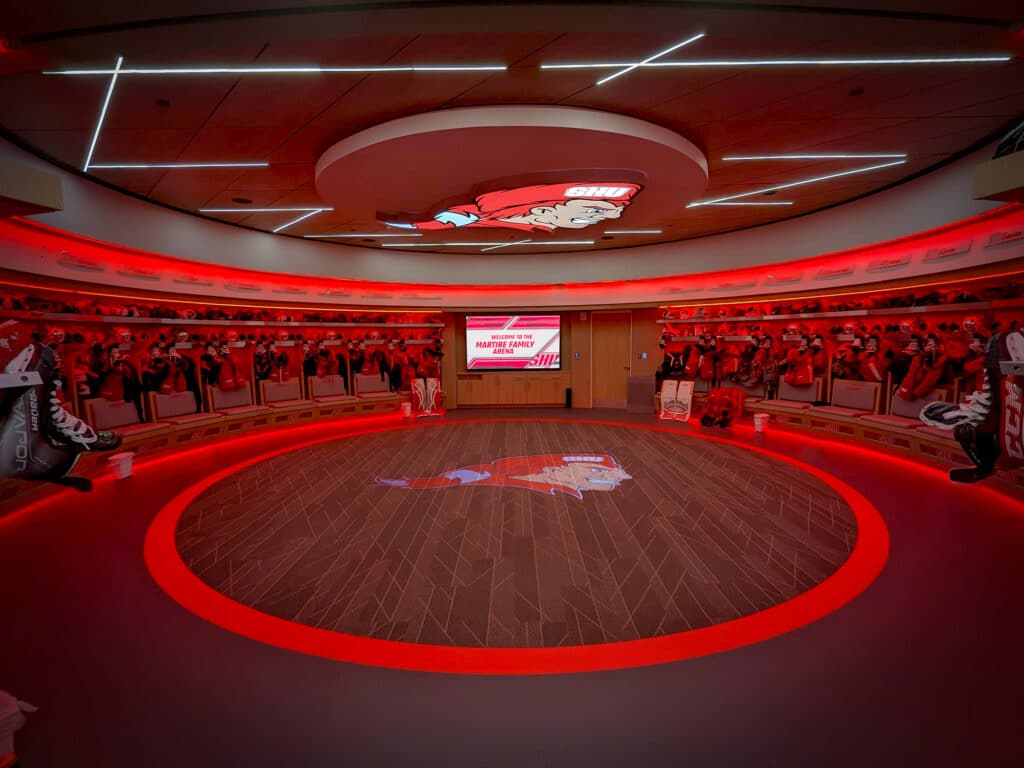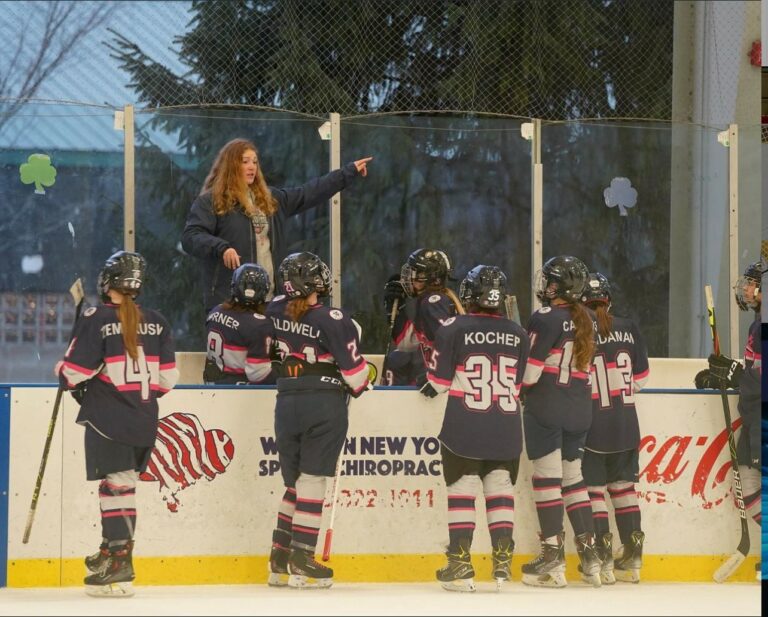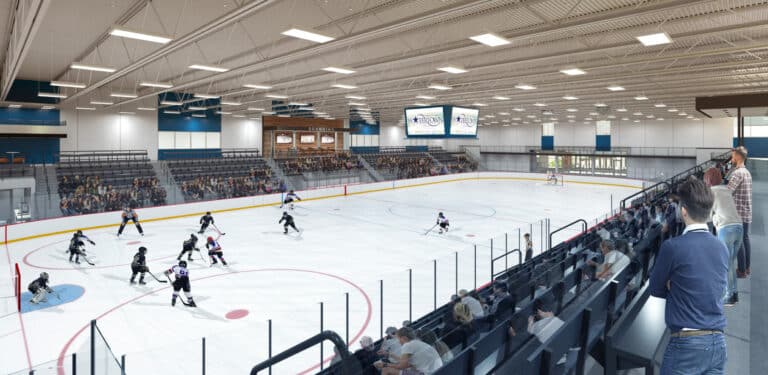In honor of Women’s History Month, let’s drop the puck and give one more standing ovation for last year’s 50th Anniversary of Title IX. As hockey facility designers, we saw this moment change the game for good, starting with a goal for equitably designed facilities that invest in the best athletes, regardless of gender.
Rethink the Rink
JLG Architects has been at the helm of hockey facility and rink design for over three decades, and we’ve been happy to steer the change. As we envision a brighter 2023, we want to ensure female athletes are no longer sitting on the sidelines of facilities made for men – or searching for space to play at all.
“Nobody has had the opportunity to do a lot of design for women’s hockey,” said JLG’s Randy Lieberg, the country’s only Certified Ice Technician and a Certified Ice Rink Manager who is also a registered architect. “Although several universities have dedicated funding and space for women’s programs, in comparison to men’s hockey, women’s hockey has been woefully underserved by proper facilities.”
In states like Michigan and many others, it’s tough to find a Division 1 Women’s Ice Hockey team. The University of Michigan Women’s Ice Hockey team currently operates as a club sport and competes in the American Collegiate Hockey Association (ACHA) and the Central Collegiate Women’s Hockey Association (CCWHA) at the Division 1 level. While Men’s Ice Hockey boasts nearly 70 Division 1 teams, Women’s Ice Hockey is on the move with 34 – the newest being University of Jamestown, Lake Superior State University, Aurora University, Montana State University, and the University of Wyoming.
Normalizing Inequity
As a former player and current Women’s Ice Hockey coach for the University of Michigan Wolverines, Jenna Trubiano has lived through the challenges dated facilities impose on female athletes.
Throughout her youth hockey career, the humiliation of inequitable facilities often put an unwelcome target on her back.
“When I was the only girl playing with boys, they put me in a storage closet and they were required to put a magnet on it that said, ‘girl’s locker room’ – and it was pink. That’s great to notify everybody, but then all the boys would come knocking on my door trying to get me to come out,” Trubiano recounted.
“Today, if I were to go to the front desk and say that I’d like my own locker room, they would have to honor that, or they should, but sometimes facilities fill up and there are no other options,” said Trubiano.
Trubiano and the Wolverines continue to face these challenges on the road today.
“We go to a lot of the older rinks where we end up having to share some sort of facility with a boys’ program. Typically, there’s a locker room on each side and then there’s a conjoining bathroom, so you can’t really put women in one room and men in the other because hockey players tend to shower afterward,” she explained.
Investment + Exposure = Revenue
To build interest and investment in more equitable facilities, fans need to first see what they’re missing.
“If you invest in women’s sports, people are going to watch it,” said Trubiano. “Data tells us that people want to watch women’s sports – it just has never been on the platform for consumers to be able to watch.”
“There’s a lot of push to make things equal right now, but we’re not going to catch up to men’s hockey overnight – it takes time to grow anything,” said Brian Idalski, Head Women’s Hockey Coach at St. Cloud State University.
It didn’t take 20 years of coaching for him to see that wins and losses are directly related to revenue.
“The hard part is you have to be exposed to women’s hockey for it to grow. People often talk about expenditures and being non-revenue, and I understand that, but it has to start somewhere,” said Idalski. “The investment is for the further development of people, athletes – and they deserve those opportunities.”
“The resources and assets have improved, and so has the talent level, the skill, and the overall numbers. It all goes hand in hand. You don’t have to be a genius, whether internationally or collegiately, to go find who spends resources and then find out how they finish – it’s basically one for one.”
Easing into Equality
Is it easy to design equitable facilities? The answer is both yes and no. Outside variables have made it difficult to provide what most consider ‘equal’ amenities.
“Constraints come in the form of square footage limitations, low budgets, athletics program structure, or existing facilities – stacking heavy challenges onto an already complex project process,” said JLG’s Sports Practice Studio Leader, Tom Betti.
“We can provide the same facilities, and there are no differences in the fields or ice they play on. Unfortunately, there is not always equity in the creation and distribution of these facilities at universities, in professional sports, and in private sports.”
Female athletes may have learned to skate over the cracks in the system, but that doesn’t mean they’re ignoring the problem.
“They say it’s a money issue,” said Trubiano. “I don’t really believe that at big schools, but at small schools that might be. At the end of the day, everybody should have at least access to the same things. It shouldn’t matter whether you’re a male or female athlete. Everybody’s there to go to school and play their sport.”
Miranda Deutz, a designer in JLG’s Sports Studio, echoes Trubiano’s plea with a solution focused on details designed for all athletes.
“We have to find out what is important to both male and female athletes; what will help them be a successful athlete; and what would make them feel safer and more comfortable within their facility,” said Deutz “We need to be purposeful, ask in-depth questions, and include the finite details, then we have created a space centered around the athlete and not the gender.”
Beyond the Ice
One hot debate that’s slowly cooling off is the amount of off-ice square footage allocated to women’s versus men’s teams.
“Women require different facilities and often need more private changing areas or locker entrances, therefore should be treated with the same level of thought and detail as a men’s facility,” said Deutz. “We don’t need to simply take space and amenities that have functioned for men’s hockey athletes and apply it for women. We have achieved far more impact by intentionally designing for what female hockey athletes need to be successful both on and off the ice.”
“The game has evolved for both men and women,” said Idalski. “Everyone trains now, everyone has a great strength coach, everyone understands the fitness component, but now arenas have become a recovery and nutrition facility. Players want kitchen capabilities so they can grab a snack or smoothie, or even have dinner pre- or post-workout, fitting into their class and practice schedules.”
The change Idalski sees is spot-on. This evolution is transforming the way architects look at facility design and its impact on performance – an impact that should serve more than one gender.
Trailblazers
Because we love seeing female athletes blaze new trails around every rink, we can’t forget to celebrate the facilities working to minimize the divide for women’s sports:
JLG’s Sports Studio just saw the January 2023 completion of Martire Family Arena at Sacred Heart University (SHU) – one that is already setting an exceptional example of equality, inclusion, and balance.
SHU was intentional in its design – planning for its women’s hockey program to have equal amenities and level of design as the men’s, including women’s player spaces and designated women’s coaches and women official’s locker rooms. Martire Family Arena was designed with locker rooms for both its Club Figure Skating and Club Women’s Hockey.
Find out more about Martire Family Arena at: Sacred Heart University Martire Ice Arena | JLG Architects
Another JLG client making great strides is Augustana University, which recently started construction of the JLG-designed Midco Arena.
“Their goal has been to create balance for both men and women, something we would not have seen in the past with any university,” said Deutz. “Augustana doesn’t have a women’s hockey team yet, and they are currently kick-starting their men’s hockey team, but they wanted to make sure the amenities are balanced for their current women’s soccer team.”
Here, female soccer players will have access to their own team suite, along with an elite strength training facility; a completely inclusive facility designed for all Augustana athletes.
At Xtream Arena, completed in 2020, JLG Architects worked collaboratively with athletes and facility operators to create an equitable, state-of-the-art venue supporting the University of Iowa Women’s Volleyball and Basketball team, Women’s Club Hockey teams, youth leagues, and the Iowa Heartlanders ECHL hockey teams.
Another JLG client, St. Cloud State University has been an early adopter of providing equal spaces for men’s and women’s hockey.
Twenty-five years ago, St. Cloud State University opened the doors to what most would see as a male-dominated ice center in celebration of their leap into NCAA Division I hockey. That year also saw the debut of the American Women’s College Hockey Alliance, and in 2008, five women Huskies played in the Beijing Winter Olympics.
In 2013, with seven National Tournament appearances, 22 NHL players, 18 AHA All-Americans, and four Olympians, Husky Hockey joined the National Collegiate Hockey Conference and, with it, opened the new Herb Brooks National Hockey Center.
JLG’s expansion (in association with HMA Architects) shifted focus, providing a first-class, 6,000-seat collegiate hockey experience that supports both the St. Cloud State University’s Huskies Men’s and Women’s Ice Hockey Division I teams.
—
When the puck drops, it all comes down to empowering athletes and manifesting equitable worth. Anyone can see how much the industry values male hockey players – a feeling that makes its way to the ice, excites fans, and paves the way to championships. If we apply that same value to women’s hockey organizations, maybe the icy ceiling would finally crack, and the sky would be the limit.




